Congratulations to JSG’s 2022-23 Doctoral Candidates!
July 13, 2023
It’s more than two dozen! The Jackson School of Geosciences is very proud to announce the doctoral candidates for the 2022-23 academic year at The University of Texas at Austin.
Kudos to Kristina Butler, Rodrigo Correa, Natchanan (Mint) Doungkaew, Scott Eckley, Zachary Foster-Baril, Mohammed I. Fallatah, Kwun Yip Fung, Sophie Goliber, Gabriela Gutiérrez Tamayo, Erin Heilman, Naoma McCall, Nicholas Meszaros, Sean O’Donnell, Fritz Palacios, Nam Phuong Pham, Natasha Piatrunia, Simone Puel, Ana Maria Restrepo Acevedo, Sabiha Tabassum, Dimitri Voytan, Qiqi Wang, Natalie Wolfenbarger, Shuai Yan, Yanyao Zhang, and Siyu Zhao.
This post will be updated throughout the year as information becomes available from faculty and electronic theses are posted by UT Austin. Last updated August, 2023
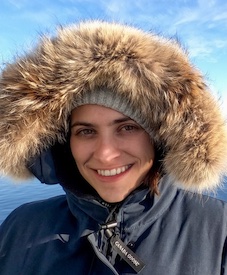
Natalie Wolfenbarger
Terrestrial Constraints on the Distribution of Brine in Europa’s Ice Shell
The project, defended on September 9, 2022, was supervised by Dr. Don Blankenship, Dr. Marc Hesse, and Dr. Krista Soderlund with committee members including Drs. William Moore, Timothy A Goudge, and Patrick Heimbach.
Abstract: Jupiter’s ice-covered moon Europa is considered a prime target in the search for habitable worlds within our Solar System. Freezing at the ice-ocean interface (accretion) entrains material from the ocean, including salts and potential biosignatures. In this work, we first examine how accreted ice on Earth can be used to estimate the bulk composition of Europa’s ice shell through a review of published ice core data, sampling low temperature gradient environments. We find that ice forming beneath ice shelves can serve as a valid analog for ice accreting beneath the ice shells of Europa and Enceladus and that the mechanism of ice accretion (frazil vs. congelation) will serve as the primary factor governing the amount of salt entrained in the ice shell from the ocean. We then introduce a framework to model the brine, salt, and ice volume fraction for a given composition as a function of bulk salinity and temperature by translating the output of the aqueous geochemistry software to polynomial functions of temperature. Using this framework, we build models for two endmember (NaCl and MgSO₄) and two multi-ion “analog” endmember (chloride-dominated and sulfate-dominated) ice shell compositions. Motivated by the observation that a percolation threshold could ultimately govern the stable bulk salinity of a congelation ice shell, we use these models to study the efficiency of salt entrainment as a function of ocean salinity, composition, and the effective critical porosity, a new parameter introduced in this work. We find that the efficiency of salt entrainment in a congelation ice shell is minimally influenced by composition and ocean salinity and is ultimately governed by the effective critical porosity. Finally, we study the habitability of ice shell brine pockets and find that they are not geochemically prohibitive to life as we know it. Furthermore, we suggest that brine volume fraction, as a proxy for nutrient transport and recycling, may be a critical factor governing the habitability of Europa’s ice shell and use it to define different classes of potential habitats within Europa’s ice shell.
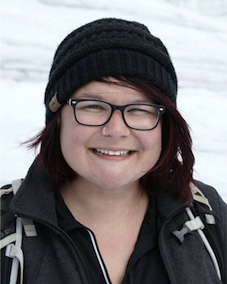
Sophie Goliber
Controls on Terminus Change of Marine Terminating Glaciers in Greenland over the Last 40+ Years
The project, defended on October 14, 2022, was supervised by Dr. Ginny Catania with committee members including Drs. Timothy Goudge, Jamin Greenbaum, Patrick Heimbach, and Kyle Spikes.
Abstract: Since the 1980s, the Greenland ice sheet has been losing ice mass at an increased rate. Our current understanding of the complex physical processes that control dynamic mass loss is incomplete and, therefore, leads to a wide range of possible future contributions to sea level. Ice dynamics, or changes due to changes in ice flux, is dominated by the behavior of fast-moving outlet glaciers in Greenland. These glaciers are changing through melting of the terminus face and/or calving of icebergs; the combination of these processes and ice motion determines the position of a glacier terminus. In understanding how and why outlet glacier termini change over time compared to external forcing and internal glacier dynamics, we are able to move toward a better understanding of marine-terminating glaciers. In this dissertation, I use terminus traces to observe how and why marine-terminating glaciers change in order to better understand the mechanisms behind these complex heterogeneous changes in Greenland. I develop the largest database of manually-traced marine-terminating glacier terminus data for use in scientific and machine learning applications. These data have been collected, cleaned, assigned with appropriate metadata, including image scenes, and compiled so that they can be easily accessed by scientists. Then I use the location of the termini to identify features in the bed topography that inhibit the retreat of glaciers following the onset of ocean warming and widespread glacier retreat in the late 1990s. I find that the slope and lateral dimensions of bed features exhibit the strongest correlation to retreat and that the shape of the bed features allows different styles of terminus retreat, which may be indicative of how different ablation mechanisms are distributed across termini. Finally, I produce a time series of terminus morphological properties for four glaciers in western Greenland to identify the characteristics that are indicative of calving processes with the goal of categorizing glaciers by calving style. I find that a concave shape and low sinuosity are present at glaciers that calve via buoyant flexure, while the opposite is true at glaciers that are dominated by melt-induced calving via serac failure. I also find that glaciers do not persistently fit into single calving styles and may change over time. By studying how the terminus changes over time compared to external forcing and internal glacier dynamics, we are able to move toward a better understanding of marine-terminating glaciers.

Yanyao Zhang
Elasticity Across the Post-Stishovite Transition in Subducted Basalt
The project, defended on October 28, 2022, was supervised by Dr. Jung-Fu (Afu) Lin with committee members including Drs. Stephen P Grand, James E Gardner, Jianshi Zhou and Chenguang Sun.
Abstract: Regional seismic studies have found many small-scale scatterers with shear wave velocity (Vₛ) anomalies near subducting slabs in the lower mantle, indicating chemical anomalies at depth. Subducting slabs transport surface hydrated mid-ocean ridge basalt (MORB) into deep Earth, which is chemically and physically distinct from the surrounding mantle. Physical properties of MORB materials are thus important to understand observed seismic Vₛ anomalies. In this dissertation, physical properties of stishovite and CaCl₂-type post-stishovite, which are abundant MORB components, have been determined at high pressure in order to study geophysical consequences across the post-stishovite transition in MORB. Specifically, I measured sound velocities using Brillouin light scattering and impulsive stimulated light scattering, Raman shifts of optic modes using Raman spectroscopy, and atomistic properties using synchrotron single-crystal X-ray diffraction in diamond anvil cells at high pressure. Sound velocity results show that the elastic modulus C₁₂ of pure-endmember stishovite converges with C₁₁ at 55 GPa where the shear wave Vₛ₁ propagating along [110] direction becomes zero and aggregate shear wave Vₛ drops by ~26%. Microscopically, this abnormal elastic property can be correlated with a crossover of the apical and equatorial Si-O bond lengths that results in the occurrence of the symmetry-breaking spontaneous strain in the post-stishovite phase. Furthermore, the Al and H incorporation into stishovite lattice structure can significantly reduce transition pressure and slightly enhance Vₛ reduction. For example, stishovite with 1.3-2.1 mol % Al undergoes the ferroelastic transition at ~16-21 GPa where Vₛ drops by ~29%. This Al,H-dependent post-stishovite transition in subducted MORB materials has been used to explain depth-dependent small-scale seismic Vₛ anomalies beneath the Tonga subduction region. The coupled H and Al substitution, together with literature element partitioning data, indicates that stishovite with 1.3 mol% Al in the upper part of the lower mantle could accommodate ~0.3 wt% H₂O.

Scott Eckley
Magmatic Thermal Histories and Emplacement Mechanisms of Martian Shergottite Meteorites
The project, defended on November 11, 2022, was supervised by Dr. Rich Ketcham with committee members including Drs. John C Lassiter, Yang Liu, and James E Gardner.
Abstract: Shergottites are meteorites originating from Mars with a broadly basaltic composition. Derived from partial melting of the mantle and filtered through the crust, shergottites provide a window into magma generation and evolution on Mars. Using X-ray computed tomography (CT), we investigated a suite of shergottites to infer details about their petrogenesis, especially their thermal histories and emplacement environments. In a novel survey of 3D olivine morphologies, sizes, and core Fe-Mg content in five olivine-bearing shergottites, we identified the common occurrence of Mg-rich olivine megacrysts with morphologies indicative of rapid crystal growth, requiring large degrees of undercooling and possibly fast cooling. This method allows us to interpret crystallization sequences and thermal histories. Results indicate that undercooling in two geochemically enriched shergottites occurs during initial magma pooling in the lower crust, a process that has not been documented in Earth basalts. Whereas, in two geochemically depleted samples, undercooling occurs later in the crystallization sequence but before the final eruption and solidification. We demonstrate the conditions needed for rapid growth are common for mafic magmatism on Mars, and that these magmas experience complex thermal histories characterized by discrete episodes of large undercooling at depth. Because shergottites were ejected from the Martian surface during impact events, their geologic contexts are unknown. We measured 3D petrofabrics and crystal size distributions in eight shergottites that span the known lithologic categories (i.e., basaltic, olivine-phyric, gabbroic, and poikiltic) to constrain their emplacement mechanisms. To contextualize the petrofabric results, we also conducted the same analyses on terrestrial igneous rocks from a variety of intrusive and extrusive environments. When interpreted in the context of the analogue study, shergottite petrofabric analyses combined with crystal size distribution analyses indicate that all samples (gabbroic, poikilitic, basaltic, and olivine-phyric) in this study were emplaced in the subsurface at various depths. This study helps to decipher emplacement styles, which is important for understanding potential interactions with crustal material, subsolidus cooling histories, shock-metamorphic processes, and potential exposure at the surface.

Kristina Butler
Mesozoic-Cenozoic Broken Foreland Basin Evolution in Northern Patagonia, Argentina (~42-46s): Integrating Sedimentation, Magmatism, and Subduction Dynamics
The project, defended on November 14, 2022, was supervised by Dr. Brian Horton with committee members including Drs. Andres Folguera, Cornel Olariu, Matthew A Malkowski, and Peter P Flaig.
Abstract:

Zachary Foster-Baril
Triassic and Jurassic Provenance, Sediment Dispersal, and Magmatism During the Breakup of Pangea, Eastern North American Margin, U.S.A.
The project, defended on November 15, 2022, was supervised by Dr. Daniel Stockli with committee members including Drs. Paul Olsen, Brian K Horton, Harm J Van Avendonk, and Amy Weislogel
Abstract:

Natasha Piatrunia
Glacial to Holocene Climate Variability in the Southern Mid-Latitudes
The project, defended on November 15, 2022, was supervised by Dr. Timothy Shanahan with committee members including Drs. Daniel O Breecker, Rowan C Martindale, Pedro Di Nezio, and Judson W Partin
Abstract: The Southern Hemisphere westerly winds play an important role in global climate, by influencing the weather in the mid latitudes, transmitting climate changes between high and low latitudes, and have been proposed to influence the carbon storage in the Southern Ocean. Changes in the position and intensity of the westerlies are anticipated to have a large impact in the future and have also been proposed to play significant role in past climate changes. Paleoclimate proxy records of past variation in the westerlies, however, are controversial, and models suggest that they may depend on a complex interplay between high and low latitude drivers as well as factors such as the mean state of the climate system. This dissertation seeks to improve our understanding of the Southern Hemisphere westerly wind and climate variations. To do so, I generate a 45,000-year record of Southern Hemisphere westerly wind and temperature variability on the North Island of New Zealand using compound-specific hydrogen isotope in sedimentary leaf waxes and branched GDGT-derived temperature using lake records. To improve our interpretations of the hydrogen isotope data in proxy records, I first examine climatic controls on the modern isotopic composition of rainfall on the North Island of New Zealand. This work indicates that isotopic ratios of precipitation mainly reflect regional-scale changes in the atmospheric circulation, with higher δ¹⁸Oₚ values reflecting an increased influence of the tropical anticyclonic circulation and lower δ¹⁸Oₚ ratios reflecting a greater contribution from the Southern Hemisphere westerly winds. Based on our improved understanding of isotopic controls, our multi-proxy record shows that Northern Hemisphere climate exerts a dominant control over the westerlies, irrespective of the changes in the southern Hemisphere mid to high latitude climate conditions. Finally, I examine the distribution of isoprenoid GDGT lipids and elemental ratios from the same lake to provide a complimentary set of proxies of lake stratification and mixing.

Naoma McCall
Geophysical Insights of the Crater Subsurface at the Chicxulub and Ries Impact Craters
The project, defended on November 18, 2022, was supervised by Dr. Sean Gulick with committee members including Drs. Michael Poelchau, Gail L Christeson, Marc A Hesse, and Richard A Ketcham
Abstract: Large impact events have shaped the evolution of life on Earth both during early Earth history and the K-Pg extinction event. They transport huge volumes of rock distances of kilometers in timescales ranging from seconds to minutes. Impacts are found on every rocky and icy planetary body and are the dominant form of crustal resurfacing on planets without plate tectonics. As impact cratering is an important geologic process, but one that is rarely observed in real time, our understanding relies on modeling and existing craters. On Earth, impact craters are often eroded, tectonically deformed, or buried in sediment. This dissertation uses drill core and seismic data at two craters largely obscured but preserved by sedimentation: the Chicxulub impact crater, Mexico and the Nördlingen Ries impact crater, Germany. My research ground-truthed impact cratering models and strengthened theories of faulting and acoustic fluidization at Chicxulub. At Ries, the data acquired, processed, and interpreted during this PhD shows that Ries is a transitional crater that exhibits neither a central peak nor peak ring and that the suevite deposition at the crater was emplaced via ground-hugging flows. I measured the permeability of peak ring rocks from the International Ocean Discovery Program (IODP) Expedition 364 core, an important parameter for determining the duration of the post impact hydrothermal system at Chicxulub, I found that the permeabilities were likely responsible for an isolated and heterogeneous post-impact hydrothermal system at Chicxulub.

Nam Phuong Pham
Deep Learning for Automatic Geophysical Interpretation with Uncertainty Quantification
The project, defended on November 29, 2022, was supervised by Dr. Sergey Fomel with committee members including Drs. Mrinal K Sen, Zoltan Sylvester, and Daniel Trugman.
Abstract: Geophysical interpretation such as picking faults and geobodies, analyzing well logs, and picking arrivals is a tedious, manual, and time-consuming process. Deep learning is a data-driven technique that has been getting more attention recently in different fields, such as medical imaging and computer vision. With large volumes of available data of different types and advancements in computing technology, geophysics is a promising field for applying deep learning. Applying deep learning to geophysical interpretation can make the process faster and the workflow less subjective. Decision-making based on interpretation is uncertain. Therefore, uncertainties in geophysical interpretation are very important. To utilize the deep learning models effectively, uncertainties from data and models’ parameters need to be quantified. In this dissertation, I address the problem by including uncertainties in several deep learning-based interpretation algorithms, and show the feasibility of applying them to various geophysical interpretation problems on different types of data. First, I develop a generative adversarial network to produce data that have style from a particular region in the field data. Different styles allow to generate different data to train various convolutional neural networks for automatic fault picking in 2D seismic images. I use a bootstrapping method to generate prediction scenarios and quantify the uncertainties from training data. Second, I introduce an end-to-end network for picking channel geobodies in 3D seismic volumes, which includes uncertainties from data and the model’s parameters. This workflow is fast and easy to quantify uncertainties, not only from data, but also from the parameters of a neural network. I then apply a similar workflow to quantify the uncertainties from the model’s parameters in picking channel facies and faults simultaneously in 3D seismic volumes. I also analyze the relationship between quantified uncertainties and geologic features in the seismic volumes. Apart from applying the workflow to the segmentation problem, I design a recurrent style network for predicting missing sonic logs from gamma-ray, density, and neutron porosity logs. This is a regression problem with two outputs of compressional and shear sonic logs. The workflow generates mean prediction and quantile values for upper and lower bounds. In the last chapter, I apply a transformer-based network for picking arrivals of earthquake data. I change from discrete labels of 0 and 1, where ones are picks, to continuous distributions with peaks at picks. This helps to quantify the uncertainties of the picking algorithm along time. Finally, I discuss some limitations and suggest some possible future research topics.

Natchanan (Mint) Doungkaew
Fracture Growth in Chemically Reactive Geologic Systems: Experimental and Field Studies
The project, defended on December 9, 2022, was supervised by Dr. Peter Eichhubl with committee members including Drs. Nicola Tisato, Mark A Helper, James E Gardner, and David N Espinoza.
Abstract:

Nicholas Meszaros
Prelude To The Latest Caldera-Forming Eruption Of The Jemez Magmatic System, New Mexico, USA
The project, defended on March 22, 2023, was supervised by Dr. Jim Gardner with committee members including Drs. Kenneth Befus, Richard A Ketcham, Jaime D Barnes, Matthew Zimmerer, and Laura Waters.
Abstract:

Siyu Zhao
Environmental Controls on African Rainfall Variability
The project, defended on March 30, 2023, was supervised by Dr. Kerry Cook with committee members including Drs. Edward K Vizy, Geeta Persad, Yuko M Okumura, and Patrick Heimbach.
Abstract: Local African communities heavily depend on rain-fed agriculture, which are vulnerable to the impacts of extreme weather and climate variability/change. However, challenges remain in predicting African rainfall. For instance, climate models with cumulus convective parametrization lack the ability to explicitly simulate mesoscale convective systems that produce much of the total rainfall over West Africa. This study aims to improve our understanding of African rainfall variability, using state-of-the-art rainfall observations and convective-permitting (CP) ensemble simulations. This work is organized into three research projects. In the first project, we evaluate the influence of Walker circulations on East African Rainfall. Three Walker circulations are identified near East Africa, namely, the East African, the Indian Ocean, and the Congo Basin Walker Circulations. Less (more) precipitation occurs over equatorial East Africa during October – December with a strong (weak) Indian Ocean Walker Circulation. The rainfall anomalies are associated with anomalous mid-level divergence over equatorial East Africa that is likely induced by horizontal moist static energy advection. In the second project, we investigate how the observed shrinkage of Lake Chad since the 1970s affects the local climate using CP simulations. A smaller lake area enhances the local precipitation by limiting the spatial extent of daytime lake breezes, which would otherwise induce low-level subsidence/divergence and suppress local afternoon rainfall. In addition, a shallow planetary boundary layer over the large lake weakens turbulent vertical mixing, reducing low- to mid-level humidity and the likelihood of convection triggering compared to the small lake. In the third project, we analyze the roles of thermodynamic and dynamic controls on intense storms over the West African Sahel with climate change. Future-Warming simulations are run with initial/boundary conditions prescribed by the current-climate data plus CMIP6 multi-model mean anomalies. The 99th (99.9th) 24-hr precipitation increases from 42 (77) mm in the current climate to 59 (104) mm in the future over the analysis region (12°N-18°N, 9°W-20°E). Increased low-tropospheric moisture (gradient) is more closely associated with this rainfall intensification than enhanced low- to mid- level vertical wind shear. Both moisture and shear conditions are related to the storm area and propagating speed that affect local rainfall accumulation.
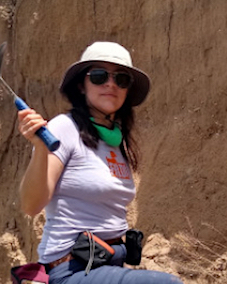
Gabriela Gutiérrez Tamayo
Provenance Signatures of Central Texas Rivers and their Erosional Geomorphic Response to the Pleistocene-Holocene Climate Transition
The project, defended in Spring 2023, was supervised by Dr. Jacob Covault and Dr. Danny Stockli with committee members including Drs. TBD.
Abstract:

Dimitri Voytan
Generative Models for Seismic Imaging and Inversion
The project, defended in Spring 2023, was supervised by Dr. Mrinal Sen with committee members including Drs. TBD.
Abstract:

Sean O’Donnell
Origin, Dynamics, and Extent of Explosive Volcanic Eruption Hazards
The project, defended on July 19, 2022, was supervised by Dr. James Gardner with committee members including Drs. Josef Dufek, Richard A Ketcham, David Mohrig, Blair Johnson, and James L Buttles.
Abstract: To be added

Sabiha Tabassum
Deciphering Changes In Rainfall Events And The Consequences Over Texas Under Global Warming
The project, defended on June 13, 2023, was supervised by Dr. Liang Yang with committee members including Drs. Daniella M Rempe, Paola Passalacqua, Charles S Jackson, and Dev Niyogi.
Abstract: The far-reaching impacts of global warming on precipitation patterns warrant our unwavering attention. As the atmosphere heats up, heightened water vapor levels lead to more intense and frequent severe weather, exacerbating the risk of floods. Conversely, shifts in rainfall distribution could incite prolonged droughts and diminished water access in specific regions. Given the societal and economic repercussions of these extremes, comprehending their evolving nature becomes paramount. This study employs General Circulation Models (GCMs) from the Coupled Model Intercomparison Project Phase 6 (CMIP6) to explore shifts in rainfall and their consequences for Texas amid global warming. In Chapter 2, I meticulously evaluate the performance of the CMIP6 GCMs in representing the observed rainfall characteristics over Texas. Subsequently, I scrutinize projections from the most accurate GCMs to estimate changes in extreme rainfall events. The analysis reveals a more pronounced increase in the annual maximum 5-day rainfall (Rx5day) in the near-future (2021-2050) than long-term (2071-2100) when compared to the historical period (1985-2014). In Chapter 3, I use a data driven approach to develop a statistical relationship between flood height at critical infrastructures and precipitation during historical tropical cyclones (TC) in Texas. This relationship is then extrapolated to anticipate future flood risks based on projected extreme rainfall. The findings illuminate heightened vulnerabilities to damage and disruptions from future TC-induced floods in specific areas. In Chapter 4, I assess prospective changes in streamflow within the Colorado River Basin (CRB) using GCMs selected based on their ability to represent the observed climatic characteristics over the CRB. The results signal substantial alternations in CRB streamflow and an escalated probability of extreme flow occurrences. Cumulatively, this dissertation underscores the urgency for adaptable strategies to confront the intricate challenges stemming from evolving Texas rainfall patterns in a warming climate.

Kwun Yip Fung
Improved Urban Extreme Weather Simulation by Capturing Urban Heterogeneity
The project, defended on June 14, 2023, was supervised by Dr. Liang Yang with committee members including Drs. Charles S Jackson, Edward K Vizy, Jay L Banner, and Dev Niyogi.
Abstract: The current observations clearly indicate a world undergoing climate change, marked by increased frequency and intensity of heat waves and heavy rainfall events since 1950. The repercussions of extreme weather in urban settings are highly variable due to the diverse environments present. These risks will disproportionately affect vulnerable populations, making it essential to study the effects of urban heterogeneity on extreme weather. This dissertation is structured into three main sections. 1. Methodology Development: The first section delves into various machine learning techniques and urban datasets to produce a precise Local Climate Zone (LCZ) map. The LCZ classification, which divides urban areas into 10 classes, aids in capturing urban heterogeneity. The random forest classifier is highlighted as producing an accurate and high-resolution output in a short timeframe. Key factors governing classification accuracy are building height and imperviousness. Building height improves the accuracy of high-rise classes, while the imperviousness dataset enhances the accuracy of low-rise classes. The refined LCZ map contributes to more accurate computational simulations of urban heterogeneity. 2. Enhancing Tropical Cyclone Simulations: The second section focuses on evaluating improvements in tropical cyclone simulations by integrating LCZ to capture urban heterogeneity. While LCZ has proven beneficial for simulating temperature, wind, humidity, and non-hurricane rainfall, its impact during tropical cyclones has been underexplored. Simulation experiments, when compared with observations, demonstrate that incorporating LCZ in urban areas enhances the accuracy of 10-m wind, 2-m temperature, land surface temperature, and rainfall hotspot locations. This underscores the significance of considering urban heterogeneity when predicting and preparing for tropical cyclones. 3. Equitable Urban Overheating Mitigation: The third section investigates the efficacy of diverse urban overheating mitigation strategies, while also addressing equity concerns. Simulations of cool roofs, green roofs, and urban trees during five heatwave events reveal that the urban trees strategy is most effective in achieving equity by cooling down vulnerable neighborhoods in Houston. This study emphasizes the necessity of factoring in city layouts and demographics to develop equitable solutions. Overall, this dissertation addresses the impacts of urban heterogeneity on extreme weather comprehensively, outlining methodologies for accurate representation, improvements in tropical cyclone simulations, and the importance of equitable urban overheating mitigation strategies.

Qiqi Wang
Fracture Spatial Arrangement in the Context of Diagenesis
The project, defended on June 30, 2023, was supervised by Dr. Steve Laubach with committee members including Drs. Julia Gale, Linda Bonnell, Nicola Tisato, Andras Fall, and Sharon Mosher.
Abstract: During the past decade, the need for meaningful documentation fracture spatial arrangement has become increasingly important as this is a key aspect of structural heterogeneity and anisotropy in the upper crust. Uncertainty about fundamental fault and fracture spatial patterns impacts engineering operations such as fluid injection underground, management of induced seismicity and the efficiency and success of fluid extraction. Spatial arrangement is an essential element in developing and managing unconventional and deep hydrocarbon reservoirs, CO2 sequestration, and geothermal systems. My dissertation research focuses on the challenge of describing and understanding fracture spatial arrangement in space. Specifically, my aim is to improve spatial characterization methods and use those methods together with other approaches to understand how the fracture patterns arise. My strategy explicitly links structure and diagenesis: the chemical/diagenetic aspects of fractures are an underutilized source of information on when and under what conditions fracture patterns arise. Fracture patterns comprise the spatial arrangements, sizes, and orientations of fractures. Moreover, cement deposits in fractures may themselves influence fracture arrangements. The central hypothesis guiding my research, is that the mechanical effects of progressive diagenesis—as manifest as deposits within fractures or as mechanical properties or property changes in the host rock—govern the types of patterns that arise. In this dissertation, Chapter 1 primarily explores and explains fracture spatial quantification methods and developing fracture pattern interpretation, but also corroborates that clustering can form independently of diagenesis (or cement deposits) within the fractures themselves. Chapter 2 explores fracture spatial patterns in a folded naturally fractured sandstone hydrocarbon reservoir using horizontal image logs and an outcrop analogue, leveraging the spatial quantification method explained in chapter 1. We discovered spatial patterns associated with high fracture intensities reflect shear on preexisting fractures, possibly resulting in more numerous but less spatially correlated open fractures. Furthermore, production data suggests that clustered but sparse quartz-lined open fractures are more effective fluid conduits than closely spaced partly damaged/sheared arrays. Chapter 3 show that due to different diagenetic histories and quartz accumulation amounts, rocks in outcrops with low thermal exposure and in the deep subsurface with extensive thermal exposure have fractures that differ in terms of their size, shape, and fracture porosity despite forming in the same sandstone host rock and in a common regional structural setting. Previous chapters set up the stage for Chapter 4, in which I address how diagenesis affects rock property evolution through time with diagenesis and rock physics modelling, in situations where timing of fractures is well attested. My results indicate that considerable magnitude of property changes can occur during fracture pattern development, and thus should be taken into consideration in fracture pattern interpretation and modeling processes.

Mohammed I. Fallatah
The Cretacious Stratigraphy and Geochemistry of the Mixed Siliciclastic-Carbonate System of Saudi Arabia: Implications for Global Correlation and Paleoclimate
The project, defended on June 30, 2023, was supervised by Dr. Charles Kerans with committee members including Drs. Mahmoud Alnazghah, Cornel Olariu, David Mohrig and Ronald J Steel.
Abstract: To be added
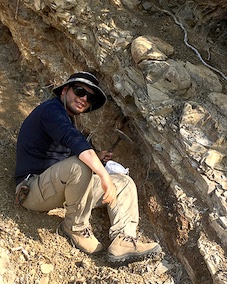
Fritz Palacios
Stratigraphic Framework, New Siliciclastic Depositional Model and Provenance Analysis in the Virgilian (Gzhelian) Cisco Group, Eastern Shelf of the Permian Basin
The project, defended on June 30, 2023, was supervised by Dr. Lorena Moscardelli with committee members including Drs. Ronald J Steel, Daniel Stockli, and Charles Kerans.
Abstract: To be added

Shuai Yan
Geophysical Investigation of Subglacial Lake Snow Eagle, East Antarctica
The project, defended on July 6, 2023, was supervised by Dr. Don Blankenship with committee members including Drs. Mrinal K Sen, Marc A Hesse, Duncan A Young, and Omar Ghattas.
Abstract: To be added

Rodrigo Correa
Structural Diagenesis and Spatial Arrangement of Fractures in Carbonate Rocks
The project, defended on July 14, 2023, was supervised by Dr. Steve Laubach with committee members including Drs. Juliette Lamarche, Michael Pyrcz, Daniel Stockli, Julia Gale, and Charles Kerans.
Abstract: Fractures are among the most intriguing features of geology. They are commonly associated with important activities in contemporaneous society, including essential energy and infrastructure development projects. However, the distribution and formation of fracture networks is still an important subject of debate, since we still do not fully comprehend formation mechanisms that would allow us to accurately predict fracture patterns in the subsurface or, in some instances, we lack adequate descriptive tools for portraying them. This dissertation focuses on the issue of fracture description and predictability by creating new statistical methods to analyze fracture arrangement and by describing petrographical and geochemical characteristics of fracture cements, also known as structural diagenesis, which allow insights into timing and conditions of fracture formation. I show how my new algorithm can discriminate several fracture spatial arrangements in 2D. Using examples from carbonate rocks, I demonstrate how a range of structural and geochemical tools together help unravel the history of fractures in two key settings: adjacent to faults and in deep-seated settings beneath salt. The results advance how to characterize fracture patterns and our understanding of how fractures form.

Ana Maria Restrepo Acevedo
Determining Vegetation Response to Ecosystem Stress: An Observational and Modeling Approach
The project, defended on July 25, 2023, was supervised by Dr. Ashley Matheny with committee members including Drs. Elizabeth Agee, Zong-Liang Yang, Daniella Rempe, and Kenneth Dunton.
Abstract: To be added

Simone Puel
A Mixed Forward/Inverse Modeling Framework for Earthquake Deformation Problems
The project, defended on July 28, 2023, was supervised by Dr. Thorsten Becker with committee members including Drs. Kaj Johnson, Marc Hesse, Luc Lavier, and Omar Ghattas.
Abstract: Subduction is responsible for the most powerful earthquakes and dangerous volcanic eruptions, resulting in significant human casualties and economic losses. However, the prediction of these natural events remains challenging due to an incomplete understanding of the underlying physics that govern these phenomena. Key questions persist regarding stress accumulation and dissipation, rock behavior under extreme pressure and temperature, and the influence of fluids and melt in these processes. Recent advancements in space geodesy and seismic networks have enabled the measurement of seismic responses and surface displacements, revealing the complex dynamics of subduction zones. To enhance our comprehension of these processes, computational modeling that integrates various types of observations and constraints is crucial. This can be achieved through forward modeling, where model parameters are adjusted to better fit the observations, or through inverse modeling, which extracts critical parameters and the underlying physical mechanisms directly from the data. However, a comprehensive numerical physics-based modeling framework that combines both forward and inverse capabilities, using adjoints, within a unified infrastructure is currently lacking. The objective of this dissertation is to address this gap by developing an open-source, flexible, transparent, and easily extendable framework capable of handling multi-physics coupled problems. This framework will also drive the advancement of innovative techniques for analyzing earthquake systems. It introduces a novel implementation of fault discontinuity within the finite-element model, an improved fault slip inversion method that does not require Green’s function computations, and a novel approach to infer material structure solely from surface displacement data, eliminating the need for seismic velocity analysis. Furthermore, by incorporating these approaches, it offers a novel joint inversion of surface geodetic data, facilitating the simultaneous recovery of subduction zone structure and coseismic slip distribution. This provides valuable insights into the interplay between heterogeneous material structure and fault processes. As a demonstration, the framework successfully recovers the coseismic slip distribution and subduction zone structure by inverting the coseismic surface displacements recorded during the 2011 M9 Tohoku-oki earthquake in Japan. The results reveal weaker material beneath several volcanoes in the same region where local coseismic subsidence was reported during the earthquake. Accounting for heterogeneity in fault slip inversions is crucial for accurately matching the surface displacement data, as suggested by previous studies. Overall, the proposed framework represents a significant advancement in subduction zone modeling, providing a comprehensive tool for understanding and analyzing these complex phenomena, thereby paving the way for improved hazard assessment and risk mitigation strategies.
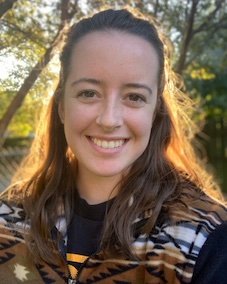
Erin Heilman
Numerical Modeling of Viscoplastic Mantle Convection with Damage Rheology to Investigate Dynamics of Plate Tectonics
The project, defended on July 12, 2023, was supervised by Dr. Thorsten Becker with committee members including Drs. Luc Lavier, Claudio Faccenna, Juliane Dannberg, and Marc Hesse.
Abstract: Mantle plumes are typically considered secondary features of mantle convection, yet their surface effects over Earth’s evolution may have been significant. We use 2-D convection models to show that mantle plumes can in fact cause the termination of a subduction zone. This extreme case of plume-slab interaction is found when the slab is readily weakened, e.g. by damage-type rheology, and the subducting slab is young. We posit that this mechanism may be relevant particularly for the early Earth, and more generally, plume “talk back” to subduction zones may make plate tectonics more episodic in certain cases. When these models are carried out in a 3-D geometry, we see the same plume-slab terminations take place and can observe the effect of lateral extent on the dynamics. We examine the dynamics of these terminations through their geometry, frequency, and effect on the surface. By varying the proportion of internal heating, we show the effect of mantle temperature on the efficacy of plume-slab terminations and draw parallels to the evolution of the Earth’s mantle temperature. A subdued version of these plume-slab interactions may remain relevant for past and modern subduction zones. Such core-mantle boundary – surface interactions may be behind some of the complexity of tomographically imaged mantle structure, e.g., for South America. Continuing the exploration of our damage rheology, we investigate spreading ridges, which are another feature integral to plate tectonics. We carry out 3-D internally heated mantle convection modeling to produce discrete spreading ridges and transform faults in a freely convecting model. The inclusion of damage in these models allows for transform faults to develop more easily than in previous modeling attempts. We vary the strength of the damage in its weakening and healing proportions to understand the effect on the dynamics and lifespan of the transform faults. These transform faults match well with observations from Earth, and as a result these models are a stepping stone to a new class of global mantle convection modeling.
Compiled by Kristin Elise Phillips